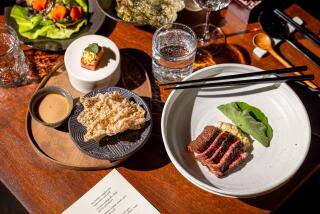Noisy restaurants: Taking the din out of dinner
You can count on the hippest restaurants to have dazzling menus, stylish servers and an attractive clientele.
And increasingly, there’s a featured side dish: noise.
As restaurateurs strive to attract a younger crowd, they’ve ditched the pile carpets, soft tablecloths and plush velvet booths for crowded communal tables, clattering open kitchens and pounding Rihanna music. And it’s all amplified by cavernous ceilings, spartan walls and bare floors.
The hustle and bustle is credited with bringing in more business, but it’s also creating a backlash.
Kristina Pivnyuk, 21, said she was hoping for an evening of fine food and good conversation when she ate recently with friends at Bottega Louie in downtown Los Angeles. She got only the meal.
“It kind of ruined the experience for me,” the Cal State Northridge student said, recalling the loud music and diners shouting to be heard over the din.
Restaurant raters have taken note.
Yelp has begun listing noise levels atop its ratings. OpenTable, a reservations service, allows reviewers to rate restaurants as “quiet,” “moderate” or “energetic.” Several national restaurant reviewers now factor sonic quality into their reports. The Rundown LA, which sends email blasts on local activities, provides noise ratings when it reviews eateries.
According to the nationwide Zagat survey, noise has become the second-biggest complaint among diners, behind lousy service. In Los Angeles, 18% of diners ranked noise as their top peeve last year, up from 12% in 2010.
Some restaurateurs are getting the message and looking for a middle ground between aesthetics and acoustics.
For years, eateries’ main options for decibel control involved fabric, bulky panels and popcorn ceilings. Today, more sound-damping products are available, including eco-friendly options created from cork, recycled tires and wood.
With the rising popularity of open kitchens, which put shouting chefs in plain view and earshot, architects are trying to cut down on the noise by designing work areas with lower ceilings. Culver City restaurant Lukshon installed quieter exhaust hoods to cut down the noise.
TheFather’s Officeburger chain added echo-absorbing insulation to its ceilings. The ceiling at the new Umamicatessen downtown features noise-catching aluminum panels, which use varying thicknesses and heights to reduce the din by as much as 28%. The recently opened Mendocino Farms in Mid-City has partitions swathed in artificial grass.
“It has worked wonders,” chef Josef Centeno said of the insulation installed throughout his Baco Mercat restaurant downtown, which he sprayed with soundproofing paint. “Before it went in, the noise was unbearable.”
Bottega Louie is making changes too. The eatery has high ceilings, marble floors, bare walls, a long line of waiting guests and several Yelp reviews from people who said they lost their voices hollering to be heard inside.
This spring, the restaurant finished installing sound-absorbing materials under its chairs and banquettes, said general manager Matt Daniel. Servers were trained to pace themselves better so they didn’t end up juggling armfuls of clanking plates. The music, which operators used to crank up, is now left soft.
“The energy, the environment is part of why our guests are choosing to come to us,” Daniel said. “We don’t want to turn it into a library type of environment. But we also want our restaurant to be appealing to as many people as possible.”
As technology prices fell in recent years, more eateries could afford better sound systems and even disc jockeys. The intimate aesthetic of the 1980s and ‘90s gave way to exposed metal, concrete and other sound-reflecting materials that look sleek and are easier to maintain.
After the recession, many of the surviving establishments found that leisurely settings good for conversation weren’t conducive to diner turnover and therefore higher sales.
To boost revenue, they crammed tables closer together and turned to fast, loud music, which several studies have shown prompt customers to chew faster, order more drinks and finish their meals sooner.
At the same time, the onset of smartphones, Twitter and Yelp helped spread foodie culture, especially among young gourmands. Communal dining became popular, leading designers to ditch the tall, secluded booths in favor of cafeteria-style rooms and long benches.
Some diners, such as 35-year-old Fred Chien, enjoy the resulting hubbub. He said it helps him relax after a long workweek and allows him to talk without having to worry about bothering other patrons.
“Usually restaurants that are good and popular will be noisy,” said the Huntington Beach physician, whose favorite restaurants include the boisterous Gjelina in Venice and Pizzeria Mozza and Red Medicine in Los Angeles.
But more customers — especially older ones and business professionals — are fleeing to restaurants with outdoor tables, dedicated side rooms and mellower lunch hours.
Retired Cheviot Hills art teacher Doris Spivack, 68, makes a point to avoid establishments with the bass-heavy soundtracks and bar chatter that she finds “extreme.”
Instead, she visits quiet restaurants such as Capital Grille at the Beverly Center, which she said tempers conversations and cellphones with its carpeting, tablecloths and spaced-out booths and tables.
“The quieter restaurants are really hard to find,” she said. “But they’re so much more enjoyable.”
Now, it seems, younger diners may be starting to feel the same.
More to Read
Eat your way across L.A.
Get our weekly Tasting Notes newsletter for reviews, news and more.
You may occasionally receive promotional content from the Los Angeles Times.







